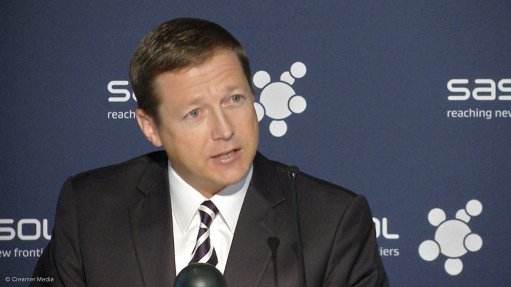
Sasol CEO David Constable
Energy and chemicals group Sasol will pull the trigger on its streamlined operational structure on July 1, with CEO David Constable forecasting a minimum of R3-billion in sustainable yearly savings as a result of the reorganisation.
However, the ‘business performance enhancement programme’ will also affect some of the JSE-listed company’s 34 000 employees and will cost upwards of R2.5-billion to implement, with restructuring costs of R1.2-billion forecast for 2014 and “peak” costs anticipated during the 2015 financial year.
Constable refuses to put a figure to the number of jobs that could be affected, saying only that the restructuring impacts are being communicated to employees through the group’s partnership forums, in which all recognised unions are represented.
It has been reported previously that the reorganisation, which has been dubbed Project Phoenix and has been partly facilitated by Bain & Company, could affect as many as 1 000 jobs.
But Constable insists that no “specific numbers” have been communicated and says the focus is currently on the “upper and top levels of management” comprising the group executive committee (GEC) and the three layers below the GEC.
“The three levels below the GEC are where we will see some impact through July 1, 2014, which is day one for the new operating model. As the numbers firm up going forward, we will come up with more details.
The restructuring follows a two-and-a-half year process during which Sasol has reset its strategy and has prioritised dealing with “cost creep”, which is threatening to erode the group’s future performance.
The focus on costs was already evident in Sasol’s latest results, when a 26% rise in headline earnings to a record R30.19 a share was reported for the six months to December 31, 2013. Cash generated from operations rose to R28-billion and the company also announced a record interim dividend of R8 a share.
Sign-off has been received for both the strategy – which is premised on ‘nurturing and growing’ its Southern African businesses and ‘expanding and delivering’ its ambitions capital projects in the US – and the latest organisational structure.
A new value-chain-focused structure will replace the prevailing product-centric model, while the management hierarchy and decision-making layers will be reduced.
“By way of example, we have reduced the number of group executive subcommittees from 57 to 9, that’s an 84% reduction. In addition, we have reduced the total number of meetings with our governance structure from 580 a year to 160, that’s a 72% reduction,” Constable reports.
“The management team intends using this extra time wisely, focusing on enhancing the productivity of our existing operations and on driving our strategic growth ambitions.”
The new operating model has three areas of focus, including:
• The upstream operating business units of mining and upstream oil and gas;
• The middle portion of the value chain, which will include operations clustered into regional operating hubs in Southern Africa, North America and Eurasia;
• And, customer-facing strategic business units in energy and chemicals.
In future profit and loss will be reported in the operating business units upstream and in the downstream strategic business units, with the regional operating hubs focusing on volumes and costs.
Constable argues that the new streamlined and simplified model will represent a “new era” for Sasol, which is aiming to pursue major gas-to-liquids-led growth in the US.
“We have an extremely busy and game-changing period ahead of us.”
The chemicals business is also expected to contribute more materially to cash flow, with olefins and surfactants operations (whose core-business status was at one stage in doubt) having emerged as the second-largest profit contributor with operating profits of R2.7-billion in the first half of 2014. The Synfuels unit in South Africa remains the biggest contributor, with an operating profit contribution of R16.2-billion during the period.